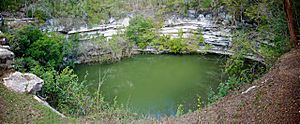Sacrifice in Maya culture facts for kids
Sacrifice was a very important religious act for the Maya people. Priests led these special ceremonies. People in almost all ancient societies performed sacrifices. They did it to show respect to their gods and to ask for their help.
Contents
Learning About Maya Sacrifices
We know about Maya rituals from two main sources. One source is old writings and books called codices. These were written by missionaries who came with the Spanish conquerors. The other source is what archaeologists find when they dig up old Maya cities.
The old writings are not as complete as those for the Aztecs. They are mostly about the later Maya period. Some people say the writers were biased because they were Spanish conquerors. But one important book by Diego de Landa is still seen as a great source of information. He wrote a lot about Maya society.
Archaeologists keep finding new things. These discoveries often confirm what the old writers said. A big step forward was learning to read the Maya writing in the 1950s. This helped us understand the carvings on many temples. Digging up sites and studying old bones also tells us about the details of sacrifices.
Sacrifices in Daily Life and Festivals
How the Maya Performed Sacrifices
The Maya had many festivals and rituals throughout the year. Many of these involved sacrificing animals. This practice was very common in ancient Mesoamerica. It is believed to have started with the Olmecs, who were the first big civilization in that area.
The Spanish priests strongly opposed sacrifice. They saw it as a sign that the Maya were not following their new Christian faith.
Diego de Landa, who later became a bishop, wrote the most detailed accounts. He described many Maya calendar festivals and rituals.

The city of Chichen Itza was a major Maya power center. It seems to have been a very important place for sacrifices. There are two natural sinkholes, called cenotes, at the city site. These provided a lot of fresh water. The largest one, Cenote Sagrado (also known as the Well of Sacrifice), was where sacrifices were made. These offerings were for the rain god Chaac.
Maya society was made up of independent city-states. This meant that local leaders and priests could decide when to perform sacrifices. De Landa noted that sacrifices were often made in temples when there were "diseases, disagreements, or droughts."
White-tailed deer were perhaps the most common animal used for sacrifice. They appear often in Maya art. After deer, dogs and various birds were also sacrificed. Other animals, from jaguars to alligators, were used too.
Animal sacrifice seemed to be a common ritual before any important task. For example, before starting a big building project or a war.
The Maya often raised animals just for sacrifices and ritual feasts. Spanish explorers reported that the Maya would kill and eat many turkeys in a yearly ritual and feast.
Old Maya books, like the Dresden Codex, show birds being used in rituals. The Madrid Codex and the Borgia Codex show deer sacrifice rituals.
At a place called Laguna de On Island, archaeologists found bones from many animals. These included tapir, peccary, deer, crocodile, iguana, and agouti. They were all found in one spot used for rituals. These animals were rare or missing in other areas. This suggests that important leaders controlled which animals were used for these rites.
At Xunatunich and Baking Pot, deer bones and turtle shells were found. They did not have cut marks from eating. This suggests they were used for sacrifices. Later records describe deer and turtles being sacrificed at these sites.
A burial site at Yaxuná had scattered bones of jaguars, rabbits, deer, opossum, birds, lizards, and snakes.
Why Sacrifices Were Important
Sacrifices were common in all ancient Mesoamerican cultures. Most experts agree that these practices started with the Olmecs at least 3,000 years ago. They then spread to other cultures, including the Maya. Why they started with the Olmecs is not fully known.
The Maya believed that there was no clear difference between living things and non-living things. Sacrifices were thought to give life or "soul" to buildings and idols. This meant that the sacrifices were seen as a real change. The Maya believed the future of the world depended on these acts.
Like all societies led by religious leaders, the Maya's political and religious leaders worked together. They supported each other's power. This helped keep society stable. Sacrifice rituals were a central part of bringing the community together. We don't know much about how different groups within Maya society felt about these rituals.
See also
 In Spanish: Sacrificio en la cultura maya para niños
In Spanish: Sacrificio en la cultura maya para niños

